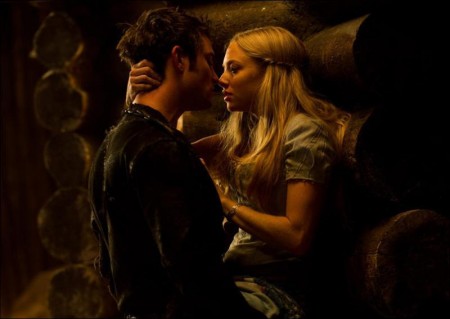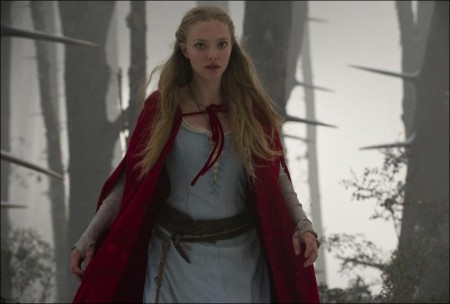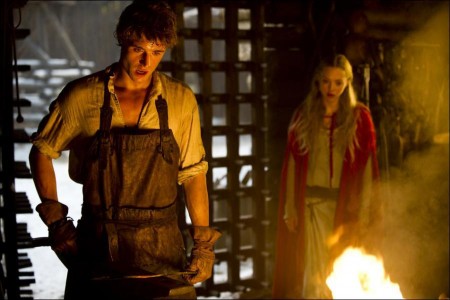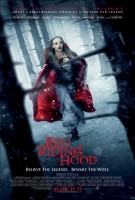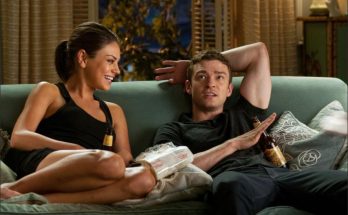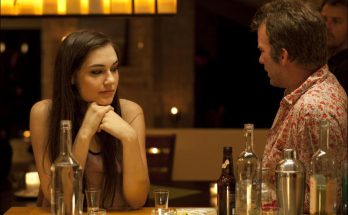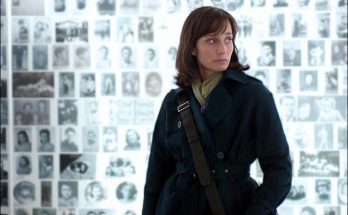Tagline: Believe the legend. Beware the wolf.
Tagline: Believe the legend. Beware the wolf.
Valerie is a beautiful young woman torn between two men. She is in love with a brooding outsider Peter, but her parents have arranged for her to marry the wealthy Henry. Unwilling to lose each other, Valerie and Peter are planning to run away together when they learn that Valerie’s older sister has been killed by the werewolf that prowls the dark forest surrounding their village.
For years, the people have maintained an uneasy truce with the beast, offering the creature a monthly animal sacrifice. But under a blood red moon, the wolf has upped the stakes by taking a human life. Hungry for revenge, the people call on famed werewolf hunter, Father Solomon (Gary Oldman), to help them kill the wolf. But Solomon’s arrival brings unintended consequences as he warns that the wolf, who takes human form by day, could be any one of them. As the death toll rises with each moon, Valerie begins to suspect that the werewolf could be someone she loves. Panic grips the town as Valerie discovers that she has a unique connection to the beast–one that inexorably draws them together, making her both suspect… and bait.
About the Production
For contemporary audiences, the title “Red Riding Hood” might conjure up fairy-tale images of an innocent little girl in a red cape heading to Grandmother’s house. But, in fact, the original story was a cautionary tale of danger and deception intended to frighten impressionable, young minds.
Director Catherine Hardwicke notes it’s the story’s more sinister roots that lend themselves perfectly to a fantasy thriller. “Most of us grew up with a sanitized version of Red Riding Hood, but the original fairy tale has darker elements that make it much more intriguing. The idea of a girl going into the woods by herself and having a wolf stalking her and then speaking to her… That holds so much mystery and captures your imagination on so many levels. When you were a child, the story might have meant one thing to you, but looking back on it as a teenager or adult, you respond to it in a completely different way.”
Producer Jennifer Davisson Killoran offers, “It’s an iconic story, and although we may have heard different versions, there are things that are universal: the red cloak, the wolf, the lie, the fear. It’s so simple and yet so terrifying. We were excited about the idea of taking this time-honored tale and changing it up for a modern audience.”
The implicit message of the Red Riding Hood fable is: don’t talk to strangers. But what if the wolf turns out to be someone you know…someone you trust…someone you love? Killoran observes, “The story plays into our fears that someone close is not really who they appear to be. To me, the big, bad wolf represents the anxiety of not knowing who you’re really dealing with.”
Putting a twist on the classic tale, the predator in the film is a werewolf, giving it the guise of a human until a full moon illuminates its true nature. Building on that premise, screenwriter David Leslie Johnson crafted a murder mystery in which everyone is a possible suspect and the resulting terror and paranoia permeates an entire community.
“I think David did a beautiful job,” states Hardwicke. “He dove into the genesis of the legend to get at the essence of it. And then he added his own fertile imagination to the mix and really enriched the story.”
Johnson says, “I did a lot of research into how the fable had changed as it was passed down, depending on the time and place. Long before it was tied up in a nice little bow and presented as a fairy tale, it contained some graphic and rather disturbing details and the ending wasn’t quite so pat. I liked the idea of expanding on the story’s origins to generate more danger, suspense and adventure.” There is also romance. The central character, Valerie, is caught between two handsome suitors: Peter, her heart’s desire since childhood, and Henry, the man her parents have chosen for her to marry. Questions about the identity of the werewolf make her choice a matter of not only the heart but of life or death. Further complicating things, she has an encounter with the wolf and is shocked to learn they have a unique and very personal connection.
Amanda Seyfried plays the role of Valerie, whose signature red cloak gives the story its name. “The love triangle makes it more interesting because Valerie doesn’t know who to trust,” the actress says. “She loves Peter, but she is suddenly noticing little nuances about him that make her start to wonder. Could the love of her life be the werewolf? And she is also developing a closer relationship with Henry and sees what a good man he is, but questions arise about him as well. She has to figure out if what she wants is what she needs.”
The combination of young love, suspense and ancient legend immediately appealed to Hardwicke, who recalls, “As I read the script, I got very excited because it took place in a fantasy world but had a dark side. It was a thriller with unexpected turns as well as a compelling love story, which also held some surprises for me. I was really pulled in as the stakes kept getting higher, and more and more secrets and lies were unraveled.”
For the producers, the choice of Catherine Hardwicke to direct “Red Riding Hood” was an easy one. Killoran attests, “Catherine has demonstrated an ability to tap into the soul of younger audiences in a way that few others can. It’s evident in all her films; they are never condescending or stereotypical. There is something very honest in the way she conveys how teenagers communicate, how they think and how they look at the world.”
Nevertheless, the appeal of collaborating with Hardwicke spanned the different generations represented in the cast, from emerging talents to longtime veterans of the screen. Oscar-winner Julie Christie remarks, “Catherine was an absolute revelation to me. She has a fantastic youthful vitality and is so full of joy, but is also so focused and skilled in getting the job done. Working with her was an extremely positive experience for me.”
“Having seen her movies, I thought working with Catherine would be intriguing,” says Gary Oldman. “That was one of the things that attracted me to the project. And when I met her, I loved her passion.”
Billy Burke, who was the only member of the cast reuniting with Hardwicke, following “Twilight,” comments, “I have a huge place in my heart for Catherine. I’ve never met anyone with the energy level she has and it’s infectious. She has a way of infusing everyone on the set with a shared sense of purpose.”
Seyfried agrees. “You want a director who brings that much enthusiasm and excitement to the table. She just loves making movies and has so much imagination. When we were in pre-production, she showed me drawings and photos and videos she had put together, which really helped me understand the different facets of my character. She truly is the most creative director I’ve ever worked with.”
How Can You Keep Out What Is Already In?
Hardwicke says that Amanda Seyfried immediately came to mind in casting the part of Valerie. “From the first time I saw Amanda, I knew she was something special,” the director affirms. “She had everything we needed for the character, especially because Valerie is not a classic damsel in distress. Amanda is tough, she’s sexy, she’s funny, she’s vulnerable—she has it all. And the way she looks is straight out of a fairy tale. She has an ethereal quality, with the most amazing eyes that just draw you in.”
In turn, Seyfried says that this new take on an old fairy tale is what drew her in. “I don’t know anyone who didn’t read Red Riding Hood growing up, so it was cool to take a story we all know and have some fun with it. The thriller aspect was exciting to me, and the medieval setting made it feel gothic and added to the romance.”
Valerie is, at once, at the apex of the film’s romantic triangle and also directly connected to the mystery of the werewolf. When it becomes apparent that the beast is someone close to her, Valerie is given reason to question everyone in her life. “As the story unfolds, she is trying to figure out who it could be, based on the signs she’s been given,” Seyfried explains. “It’s terrifying for her because, at different points, she has cause to suspect everybody.”
Hardwicke adds, “Paranoia starts to creep in as Valerie starts seeing little details she hadn’t noticed before, and now they are taking on new meaning. Her entire life she has seen her family and friends in one light, and suddenly things have shifted, causing shadows of doubt.”
It isn’t long before those shadows fall on the two very dissimilar young men vying for Valerie’s heart, Peter and Henry, played by newcomers Shiloh Fernandez and Max Irons, respectively.
Fernandez relates, “Peter is a woodcutter, who is also Valerie’s boyfriend. They have to be secretive about their relationship because he’s a poor orphan and something of an outsider. At the start of the film, he discovers that she has been betrothed to Henry, so Peter asks Valerie to run away with him. He wants to show her the world she’s never seen—the city, the ocean…anything, as long as they can be together. But before they can go tragedy strikes. They find out Valerie’s sister, Lucie, has been murdered by the werewolf.”
We also learn that Lucie had been in love with Henry, but he only has eyes for Valerie. Irons notes, “Henry is the town blacksmith and the son of the wealthiest family in town. He can’t understand how Valerie could have her heart set on Peter because Henry honestly believes he is the better choice in terms of the life he can offer her.”
“It’s that age-old romantic dilemma: should she make the safe choice, who, in this case, also happens to be dashingly handsome, or the one who seems a bit dangerous but is sexy and exciting? I think any young woman would dream of having this choice, especially if it came in the form of Shiloh and Max,” Hardwicke laughs.
“Shiloh has so much heart and soul, and had great chemistry with Amanda,” the director continues. “He also brought some mystery to his character that leads you to wonder what might be going on beneath the surface.”
Killoran adds, “Max has this wonderfully engaging presence about him. What I loved about his performance is that everything he does comes from a place of strength and honor, but he lets you know that Henry could have a dark side, too. In casting these roles, we wanted to make it so Valerie’s decision isn’t an obvious one; it needed to be a hard choice between two equally wonderful but different men, who are both worthy.”
Coming from different perspectives, Valerie’s parents, Suzette and Cesaire, have conflicting views on whether it will be Peter or Henry who can make their daughter happy in the long run.
Virginia Madsen, who plays Suzette, offers, “Suzette believes the only way for her daughter to have a better life is to marry the rich boy, Henry, who also happens to be very nice. She thinks Valerie deserves better than the poor woodcutter, the bad boy. That’s just lust and it will never last. Then the murder of her elder daughter, Lucie, threatens to reveal secrets that make her even more protective of her one remaining child. Bottom line, Suzette doesn’t want Valerie to end up like her—married to a woodcutter, who is also a drunken fool.”
Cast as Cesaire, Billy Burke admits that his character “is a man who likes to tip a few back, but his daughter loves him and forgives his faults. Maybe her attraction to Peter is partly due to the old cliché that girls tend to be attracted to men who remind them of their fathers. Cesaire is a woodcutter himself, so he likes Peter and considers him a fine suitor for his daughter. That’s only part of the chasm that has developed with his wife over the years, which is probably due to his drinking. But Cesaire doesn’t see how that is hurting anyone, including himself.”
The family member with whom Valerie is closest is her grandmother. “They share a great bond,” confirms Seyfried. “They’ve always connected on a level beyond what Valerie has with her parents. Valerie is really inspired by how independent her grandmother is.”
In “Red Riding Hood,” Grandmother, played by Julie Christie, is decidedly not the image of the character in the classic story. Hardwicke emphasizes, “One of the first things I said was there was no way our Grandmother would be a craggy, old crone. She’s very bohemian—wearing long dreadlocks, she lives outside of the main village, deep in the woods, and there is an air of mystery surrounding her.
“We were thrilled when we got Julie Christie for the role,” she continues. “She’s so amazing and so beautiful—she took my breath away. And Julie appreciated that her character was not going to be some stuffy old grandmother.”
“She’s a non-conformist,” says Christie of her character’s eclectic lifestyle. “She’s an artist and an herbalist and something of a healer. She is very wise and understanding and has been a kind of protector to Valerie, who has always been able to trust her grandmother with her innermost secrets.”
After the werewolf strikes within her own family, Valerie runs to her grandmother’s house, even as the men of the village, thirsty for revenge, band together to track down and kill the beast. Though their hunt takes a terrible toll, the men return believing they have been triumphant. Meanwhile, the village priest, Father Auguste, trusting that he is doing what is best for his flock, has summoned the renowned werewolf hunter Father Solomon to Daggerhorn.
Lukas Haas, who appears as Father Auguste, says, “He is in complete awe of Father Solomon. I believe Father Auguste sincerely wants to do the right thing, but the fact that the wolf has killed again may also have been an excuse for him to call upon his idol. His hero worship may have clouded his judgment, but Auguste soon begins to realize who might pose the gravest danger to his village.”
Gary Oldman took on the role of the over-zealous Father Solomon, whom he describes as “a man possessed. But I don’t think of him as a villain. Rather, he has looked into the abyss and is now absolutely convinced of the righteousness of his mission. He truly believes he is the sword of God…and he has a flair for fashion,” the actor deadpans. “I thought I could have some fun with the role. I was also intrigued that it was a darker twist on what was already a dark tale. As children, stories like Red Riding Hood were probably the first time we were conscious of fear. What lies in wait out there in the woods? In the hands of Catherine Hardwicke, we see it through a different prism.”
“Working with Gary Oldman was a dream come true,” states Hardwicke. “He never ceased to astound me. He is not only a fearless actor, he’s generous, collaborative and hysterically funny. Everybody on the set had mad crushes on both Gary and Julie.”
Father Solomon arrives as the village is about to celebrate the slaughter of the wolf, but Solomon admonishes them that the terror is not over. Their “kill,” he informs them, is just an ordinary grey wolf, while the werewolf remains very much alive. Then he delivers the chilling reality: the creature, who is human by day, lives among them. It is only under a full moon that one of their trusted neighbors takes the form of the wolf. Worse yet, this is no ordinary moon, but rather a cosmic phenomenon that happens only once every thirteen years when Mars and the moon align—a blood moon. When the red moon hangs in the night sky, the non-lethal bite of the werewolf will turn the victim from prey to predator, from human to werewolf. For the next three days, the villagers’ very souls are at risk.
Who’s Afraid
The main antagonist of the story is, of course, the wolf. In “Red Riding Hood,” this integral character was not cast but, rather, created through the magic of CGI. Nevertheless, Killoran says, “Oftentimes, werewolf movies focus on the transformation, but we specifically stayed away from that. This story is not about the transition from human to wolf; it is about a wolf who also happens to be human.” Visual effects supervisor Jeffrey A. Okun worked with Hardwicke on the conception of their werewolf, which had to be as shrewd as it was vicious. He notes, “Catherine was very clear that the wolf needed to be powerful and malevolent, but also very intelligent. Her challenge to us was not so much to generate a believable creature, but a believable character.”
With that in mind, Okun and the VFX team at Rhythm and Hues worked to instill expression in the beast’s face, especially in the deep brown eyes that, for Valerie, serve as a clue to its human alter-ego. Perpetuating the mystery of the werewolf’s identity, Okun also subtly layered in elements of each character. He explains, “The trick was to grab a little something from each actor’s performance, so you might catch a fleeting glimpse of someone’s mannerisms and wonder…”
Significant research went into making the wolf’s physicality as organic as possible. The VFX team carefully studied the movements of not only wolves but hyenas, cheetahs, panthers, lions, and various dog breeds. “Our goal was to blend canine brute strength with a feline slinkiness so as not to tip our hat whether the wolf is male or female,” Okun says.
On the set, the effects team, together with the stunt team, led by Andy Cheng, incorporated a variety of methods to provide the cast a physical presence with which to interact. Each of the faux wolves was given a not-so-ferocious nickname, as listed by Okun: “We had a life-size Styrofoam cutout called Stuffy, a wolf head with fur called Fluffy, and a cardboard silhouette called Flatty.”
CGI was also instrumental in accomplishing some of the film’s inanimate elements. The sets for both the interior and exterior sequences, including the entire village of Daggerhorn, were constructed on soundstages at Canada Motion Picture Park in Vancouver, British Columbia. The production then expanded the boundaries of the stages with a combination of high-tech visual effects and more low-tech mirrors.
There was, however, one shot that needed no expansion: a fantasy moment that was actually filmed on a nearby mountaintop. As Valerie and Peter trek toward the peak, her flowing red cape is in striking contrast with the blanket of white snow. Executive producer Jim Rowe recounts, “We had to keep the unit to a minimum because—even though we were filming in summer—at that elevation, the weather can change without warning and you have to be able to get out in an instant. But it went off without a hitch.”
Within the confines of the soundstages, cinematographer Mandy Walker had the task of devising the lighting for scenes ranging from sunlit days to moonlit nights. Hardwicke comments, “It wasn’t just creating outdoor lighting on an indoor stage; we had fire and snow and all those different environments, and everything had to blend seamlessly. Mandy never ceased to amaze me in what she did.” Bringing her extensive design background to “Red Riding Hood,” Hardwicke also collaborated closely with production designer Tom Sanders and costume designer Cindy Evans in developing the overall atmosphere and look of the film.
“Catherine is very visual,” remarks Killoran. “The first time we met with her, she brought in this amazing presentation, which told us how she envisioned the movie, bringing a very cool, hip feel to a kind of gothic world. Much of what you see in the movie existed in that first presentation.”
Although the setting is clearly not contemporary, the filmmakers did not want to denote any specific time or place. “We wanted to situate it in our own little fairy-tale world, in keeping with the story’s origins,” Hardwicke affirms.
The rustic village of Daggerhorn was fashioned with some notable features, meant as indications of the threat under which the people exist. Many of the buildings are raised up on stilts “because these people are in fear of the wolf, and that way they can pull up ladders and bolt the doors and make it harder for the wolf to get to them,” the director clarifies.
Another visual clue is the thorns that are on the sides and roofs of all the buildings, as well as on the trees in and around the town. Tom Sanders elaborates, “The idea was that the whole village represents a briar patch where the proverbial rabbits seek protection from the wolves. That’s why everywhere you look you see thorns. And in the middle of the briar patch is the grandmother’s house.”
Hardwicke recalls, “We had originally pictured the grandmother’s house as just a funky, little tree house, but Tom took that idea and ran with it. He designed the house in and amongst these enormous trees so you can’t immediately see where the trees end and the house begins. And there are different layers and levels that add so much visual interest. The earthy nature of the house perfectly suited the personality of the grandmother.”
Adding to the rough-hewn feel of the village, all of the furniture in the homes was built from scratch. Set decorator Shane Vieau says, “We thought we could source what we needed, but as we got into it, we found that everything had to be of a precise shape and size. Since we had our own milled wood, we started building the furniture and it progressed from there. A few people on our team were expert woodworkers, so it was an absolute joy for them to do.”
Fabrics were used on the sets to lend color to the otherwise muted tones that are inherent to wood, stone and metals. However, there is only one place that the color red appears—Valerie’s signature cloak, from which the title “Red Riding Hood” is derived. Early in pre-production, Hardwicke consulted with illustrator Kit Stolen on the initial concepts for the all-important cloak. The director then reunited with costume designer Cindy Evans. “Cindy and I collaborated on ‘The Lords of Dogtown’ and ‘Thirteen,’ and I was so happy to work with her again. She has the most beautiful taste and really cares about every detail in making the costume fit the character. Cindy began working on the cloak design, researching styles and fabrics from around the world.”
There are actually two incarnations of the red cloak: one, seen in a fantasy shot, is 20-feet long and is made entirely of velvet; and the main one, worn throughout the film. Evans details, “We did a broad fabric search and even contemplated weaving our own cloth until I happened upon a heavy-woven, two-tone silk matka—better known as raw silk—which was perfect. I had a whimsical swirling pattern silk-screened about ten inches around the border and then had the pattern hand-embroidered over it using six different tones of red. It all turned out quite lovely.”
“It was beautiful,” Amanda Seyfried attests. “Wearing it did make me feel like a fair maiden in a storybook.”
For the costumes of Valerie’s two suitors, Evans went for contrast, noting “Peter’s style comes from necessity; Henry’s comes from wealth. We wanted Peter to have an edgy look. As a poor woodcutter, Peter would have made his clothes from bits of leather and scraps of material that he stitched together. Henry was the opposite. Coming from an affluent family, he had the money for more tailored clothing.”
Evans and Hardwicke saved the most extravagant look for Father Solomon, whose deep purple velvet costume “is symbolic of his influence and wealth,” says Evans. “Centuries ago, only the most expensive dyes were used to produce the color purple. It was the color of royalty and, for us, it was a way to establish that he is a powerful individual.”
Evans and her team were also responsible for clothing the rest of the principal cast, as well as the many extras. The costumes were all crafted from natural fabrics, primarily raw silk, every piece of which had to be individually dyed and then aged.
Amongst the villagers, audiences might notice some familiar costumed fairy-tale figures, including three porcine characters who had their own problems with a big, bad wolf.
Hardwicke reflects, “I think one reason fairy tales like Red Riding Hood have endured for so long is that they allow us to explore and understand our dark sides, even as children. They portray jealousy and fear and even death, and allow us to deal with them in a very visceral way.”
Red Riding Hood
Directed by: Catherine Hardwicke
Starring: Amanda Seyfried, Gary Oldman, Billy Burke, Shiloh Fernandez, Max Irons, Virginia Madsen, Lukas Haas, Julie Christie, Christine Willes
Screenplay by: David Johnson
Production Design by: Thomas E. Sanders
Cinematography by: Mandy Walker
Film Editing by: Nancy Richardson, Julia Wong
Art Direction by: Don Macaulay
Set Decoration by: Shane Vieau, Mark Tompkins
Costume Design by: Cindy Evans
Music by: Alex Heffes, Brian Reitzell
MPAA Rating: PG-13 for violence and creature terror, and some sensuality.
Studio: Warner Bros. Pictures
Release Date: March 11, 2011
Hits: 86

